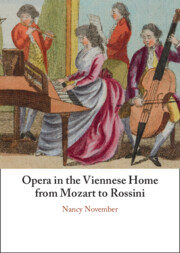Book contents
- Opera in the Viennese Home from Mozart to Rossini
- Opera in the Viennese Home from Mozart to Rossini
- Copyright page
- Contents
- Figures
- Tables
- Musical Examples
- Acknowledgements
- Introduction
- 1 Opera in the ‘Fruitful Age of Musical Translations’
- 2 Kenner und Liebhaber
- 3 Female Agency in the Early Nineteenth-Century Viennese Musical Salon
- 4 Canon Formation, Domestication, and Opera
- 5 Rossini ‘As the Viennese Liked It’
- 6 Industry, Agency, and Opera Arrangements in Czerny’s Vienna
- Bibliography
- Index
Introduction
Published online by Cambridge University Press: 18 February 2024
- Opera in the Viennese Home from Mozart to Rossini
- Opera in the Viennese Home from Mozart to Rossini
- Copyright page
- Contents
- Figures
- Tables
- Musical Examples
- Acknowledgements
- Introduction
- 1 Opera in the ‘Fruitful Age of Musical Translations’
- 2 Kenner und Liebhaber
- 3 Female Agency in the Early Nineteenth-Century Viennese Musical Salon
- 4 Canon Formation, Domestication, and Opera
- 5 Rossini ‘As the Viennese Liked It’
- 6 Industry, Agency, and Opera Arrangements in Czerny’s Vienna
- Bibliography
- Index
Summary
This study takes a novel approach, privileging opera arrangements over original operatic compositions, and the perspectives of amateur performers over those of composers. Several studies of opera arrangements from the era in question have already been published, which focus on particular composers or particular arrangement forms; and the emphasis lies on arrangements’ function as reception documents. This study differs in considering arrangements’ multiple functions, and ‘end users.
Keywords
- Type
- Chapter
- Information
- Opera in the Viennese Home from Mozart to Rossini , pp. 1 - 10Publisher: Cambridge University PressPrint publication year: 2024

